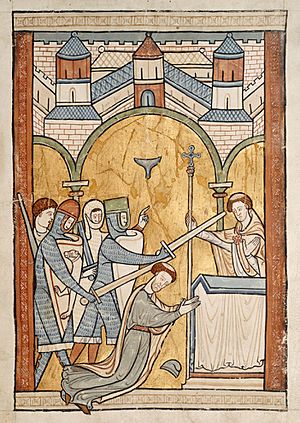Richard le Breton facts for kids
Sir Richard le Breton (also known as Richard de Brito) was one of four knights involved in the attack that led to the death of Thomas Becket in 1170. Becket was the Archbishop of Canterbury at the time.
Who was Richard le Breton?
Richard le Breton came from a family with lands in Somerset, England. His family, the "Brito" or "le Bret" family, had been in England since the time of William the Conqueror. They held land in places like Sampford Brett.
Richard's father, Simon le Bret, was a knight who served in the household of King Henry I. Simon also had connections to the feudal barony of Dunster, meaning he provided military service for his land.
Richard le Breton himself was close to King Henry II's brother, Prince William. This connection would become important later.
The Attack on Thomas Becket
In 1170, Richard le Breton was one of four knights who confronted Thomas Becket. The other knights were Sir Reginald Fitzurse, Sir Hugh de Morville, and Sir William de Tracy.
During the intense confrontation, Richard le Breton is said to have struck Becket with his sword. One account describes how his sword broke on the stone floor after hitting Becket's head.
An old record by Edward Grim describes the scene:
... The third knight struck a serious blow to the fallen man. With this strike, he broke his sword on the stone, and Becket's large crown separated from his head. The blood mixed with brain, coloring the church floor with shades of white and red, like the colors of a lily and a rose...
It is reported that Richard le Breton shouted, "Take that, for the love of my lord William, the king's brother!" This suggests he was acting partly out of loyalty to Prince William. Some believed Prince William had been deeply upset because Thomas Becket had not allowed his marriage.
What Happened After?
After the attack, the four knights quickly left the scene. They first went to Scotland and then to Knaresborough Castle in Yorkshire.
The Pope, Pope Alexander III, was very upset by Becket's death. At Easter in 1171, he officially removed all four knights from the Church. This is called excommunication. The Pope then ordered them to go on long journeys to the Holy Land as a form of penance, which means showing sorrow for their actions. These journeys were meant to last 14 years.
Richard le Breton eventually settled on the island of Jersey. There is a special stone slab, called a ledger stone, for one of the le Bretons of Jersey in St Thomas's Church in Salisbury.
Some families today, like the Brett family of Whitestaunton in Somerset, are believed to be descendants of the Brettes from Sampford Brett. This family includes the present Brett family, who hold the title of Viscounts Esher.


